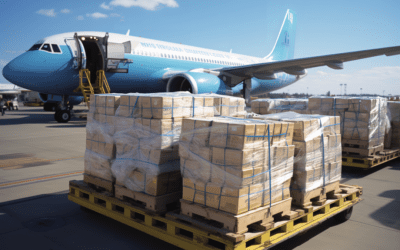There is an abundance of perishable, fragile, and important freight that travels across the globe and on our roads every single day. Perhaps none is more important, however, than the medications that keep us healthy and happy. The pharmaceutical supply chain is a complex sector that has experienced significant growth over the past two decades. From 2000 to 2019, the global economy for pharmaceutical goods jumped from $113 billion to $629 billion.
The industry will need to address key factors for the pharmaceutical supply chain to keep up with the growing momentum. Growing trends in 2022 and beyond include more demand for temperature-regulated storage, preparation for new pharma supply chain legislation, and a growing reliance on automation and artificial intelligence (AI). Supply chain members must carefully consider each factor when transporting a high-demand, potentially life-saving commodity.
Article Overview
How Medications Move Through the Supply Chain
The medications we consume rarely come directly from the manufacturer to our neighborhood pharmacy. After producing the medications, manufacturers will usually send them to a wholesaler for further distribution. For example, if a drug produced in China or India is going to the United States, it will be flown or shipped to a wholesaler within the destination country for further distribution.
Third-party wholesalers are contracted to handle storage, collect data, and distribute pharmaceuticals to their next destination. Wholesalers Cardinal Health, McKesson and AmerisourceBergen distribute 90% of the medications sold in the U.S.
Unless the medication is produced domestically, this is typically how pharmacies get their inventory. It may seem basic on the surface, but several critical details must be considered for transportation. One of them is the proper storage of temperature-sensitive medications.
Importance of Cold Chain Logistics in Pharmaceutical Transportation
Medications that require cold storage are becoming more common in the supply chain. From 2014 to 2020, the need for temperature-controlled transport rose by 65%. Other transportation needs only rose about 32%. This is in part due to the growth of biologic drugs such as insulin and vaccines rising to nearly double that of other medications.
Biologic drugs are pharmaceuticals that require special storage conditions and refrigeration. Unlike other medications that are manufactured by manipulating basic chemicals, biologic drugs are made from living microorganisms or plant/animal cells. For them to be effective, they must be kept at the correct temperature during every facet of transport and storage.

Temperature Regulation
As this industry grows, so too does the need for temperature-controlled warehouses, trailers, and shipping containers. When stored incorrectly, biologic drugs can become ineffective or even toxic to the consumer. This puts the burden of responsibility on the people transporting or storing the product. Unfortunately, some carriers and/or warehouses are not able to meet the demands of the pharmaceutical supply chain.
A recent study on temperature sensors for pharmaceutical products discovered that more than 32% of all mail-order medications are subjected to excessive heat conditions during transportation. Another study sought to find out the temperature-regulating prowess of five common packaging techniques used by pharmacies for direct-to-patient delivery. It found that none of the five were able to keep the products stable at the necessary temperature for the required 24 hours.
Spoiled medications due to incorrect shipping methods can be extremely costly, but thankfully, it’s avoidable. As the need for biologic drugs grows, having access to temperature-controlled storage and transportation capabilities will be crucial to ensuring safe transit.
Drug Supply Chain Security Act (DSCSA)
On November 27, 2023, the way U.S. companies ship pharmaceuticals will change drastically. Although that’s still over a year away, the FDA is insisting that these companies meet multiple standards by the deadline in order to comply with the Drug Supply Chain Security Act (DSCSA).
In addition to improper storage during transportation, far too many drugs get lost or mislabeled along the pharma supply chain. Without proper labeling and tracking, illegal online pharmacies can operate without a paper trail and continue selling potentially dangerous counterfeit medications.
The DSCSA aims to improve transparency and accuracy by requiring interoperable exchange, verification, and tracing of medication throughout the pharma supply chain. For pharmaceutical stakeholders to continue operating as normal, they must adhere to the following guidelines:
- Interoperable Exchange
All trading partners receive transaction information and statements through electronic sharing systems.
- Interoperable Verification
Shipments received must match the corresponding product’s tracking data.
- Interoperable Tracing
Each leg of the supply chain identifies products by their unique serial number, expiration date, and lot number.
Failure to adhere to these guidelines could be catastrophic. Businesses could face negative reputations, jail, or loss of business licenses. Companies must meet the DSCSA deadline in 2023 to continue normal operations, but it would also be prudent to expect even more initiatives in the future. The guidelines are extensive, but technological improvements are making the process of data exchange much easier and more transparent.
Packaging Automation and Artificial Intelligence
One way to improve data exchange and increase verification accuracy is to implement automated packaging techniques. Robotics package medications efficiently and accurately, and offer sustainable practices for businesses.
Artificial intelligence allows for extensive technological solutions. It can be used in conjunction with other online medical systems to order medications, cancel further production, or even predict future orders. Utilizing AI technology in the packing and shipping process can drastically reduce labeling errors. It also allows for instant data exchange per the guidelines established by the DSCSA.
Warehousing and Workers
Not only can automation improve accuracy, but it can also alleviate the shortage of warehouse workers. An extensive Berkshire Grey study of robotics in the warehousing sector found that 71% of warehousing executives believe implementing more technological automation is crucial for attracting more workers. Warehouse employees seem to agree, as 46% believe automation will reduce their stress at work. 40% think it will improve their accuracy.
Overworked employees are a hazard and liability in the pharmaceutical environment. Strict regulations are in place to prevent mistakes and ensure the safety and efficiency of medication care.
The pharmaceutical supply chain is a vital piece of our economy and has seen incredible advancements in the last three years. Each leg of transportation must be meticulously planned to ensure lifesaving, as well as everyday, medications remain safe for consumption while abiding by mandatory regulations.






